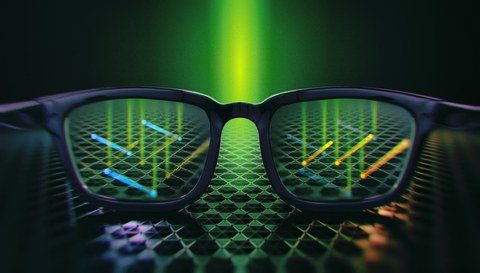Jul 13, 2023
Using Hi Tech to Illuminate Quantum Mysteries: “3D Glasses” for Topological Materials

In a breakthrough experiment reminiscent of 3D cinema, scientists used light particles (X-rays, shown in green) to unravel the mysteries of electron behavior in the kagome metal TbV6Sn6. An international team collaborating with the Würzburg-Dresden Cluster of Excellence ct.qmat has advanced our understanding of quantum materials by using circularly polarized X-ray light in a photoemission process to detect different electron rotations.
In a breakthrough akin to the effects of 3D cinema, scientists are using light particles to uncover the mysteries of electron behavior and propel our understanding of quantum materials forward. These materials, rich with potential for energy-efficient electronics and cutting-edge technology of tomorrow, are distinguished by their topological properties that could rarely be measured directly – until now. An international team of researchers, together with the Würzburg-Dresden Cluster of Excellence ct.qmat, has made a significant leap forward by successfully validating a core feature of topological materials for the first time experimentally. The findings have been published in the esteemed journal Nature Physics.
Proof at last
A standout feature of topological quantum materials is their ability to conduct spin-polarized electrons on their surface, even though they lack conductivity within. In the case of spin-polarized electrons, the intrinsic angular momentum – the particle’s rotation or “spin” – doesn’t simply align randomly.
To distinguish topological materials from conventional ones, scientists used to study their surface currents. However, an electron’s topology is closely linked to its quantum mechanical wave properties and its spin. This relationship has now been demonstrated directly by means of the photoelectric effect – a phenomenon in which electrons are released from a material, such as metal, with the aid of light.
Visualizing the topology of electrons with “3D glasses”
Professor Giorgio Sangiovanni, a founding member of ct.qmat in Würzburg and one of the theoretical physicists in the project, likened this discovery to using 3D glasses to visualize the topology of electrons. As he explains: “Electrons and photons can be described quantum mechanically as both waves and particles. Therefore, electrons have a spin that we can measure thanks to the photoelectric effect.”
To do this, the team used circularly polarized X-ray light – light particles possessing a torque. Sangiovanni elaborates: “When a photon meets an electron, the signal coming from the quantum material depends on whether the photon has a right- or a left-handed polarization. In other words, the orientation of the electron’s spin determines the relative strength of the signal between left- and right-polarized beams. Therefore, this experiment can be thought of like polarized glasses in a 3D cinema, where differently oriented beams of light are also used. Our ‘3D glasses’ make electrons’ topology visible.”
Headed by the Würzburg-Dresden Cluster of Excellence ct.qmat – Complexity and Topology in Quantum Matter – this ground-breaking experiment, along with its theoretical description, is the first successful attempt at characterizing quantum materials topologically. Professor Sangiovanni points out the essential role of a particle accelerator in the experiment, stating: “We need the synchrotron particle accelerator to generate this special X-ray light and to create the ‘3D cinema’ effect.”
Quantum matter, particle accelerators and supercomputers
The journey to this monumental success spanned a period of three years for the researchers. Their starting point was the kagome metal TbV6Sn6, a quantum material. In this special class of materials, the atomic lattice has a mixture of triangular and honeycomb lattices in a structure reminiscent of a Japanese basket weave. Kagome metals play an important role in ct.qmat’s materials research.
“Before our experimental colleagues could start the synchrotron experiment, we needed to simulate the results to make sure we were on the right track. In the first step, we devised theoretical models and ran calculations on a supercomputer,” says Domenico di Sante, the project lead and a theoretical physicist, who is also an associate member of the Würzburg Collaborative Research Center (SFB) 1170 ToCoTronics. The findings from the measurements lined up perfectly with the theoretical predictions, enabling the team to visualize and confirm the topology of the kagome metals.
International research network
The research project involved scientists from Italy (Bologna, Milan, Trieste, Venice), the UK (St. Andrews), the USA (Boston, Santa Barbara), and Würzburg. The supercomputer used for the simulations is in Munich, and the synchrotron experiments were performed in Trieste. “These research findings perfectly illustrate the remarkable results theoretical and experimental physics can produce when working in tandem,” concludes Professor Sangiovanni.
Publication:
Flat band separation and robust spin Berry curvature in bilayer kagome metals
Domenico Di Sante, Chiara Bigi, Philipp Eck, Stefan Enzner, Armando Consiglio, Ganesh Pokharel, Pietro Carrara, Pasquale Orgiani, Vincent Polewczyk, Jun Fujii, Phil D.C. King, Ivana Vobornik, Giorgio Rossi, Ilija Zeljkovic, Stephen D. Wilson, Ronny Thomale, Giorgio Sangiovanni, Giancarlo Panaccione, and Federico Mazzola,
Nat. Phys. (2023). https://doi.org/10.1038/s41567-023-02053-z
Media contact:
Professor Giorgio Sangiovanni
Institut für Theoretische Physik und Astrophysik
Julius-Maximilians-Universität Würzburg
Tel.: +49 931 3189100
